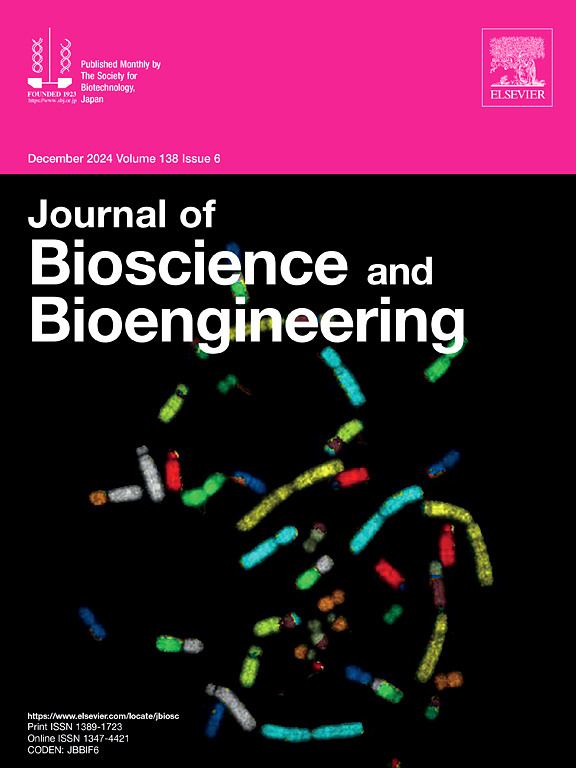蓝纹链霉菌NRRL B-2569对2′-羟黄酮的羟基化和糖醛酸化作用。
IF 2.3
4区 生物学
Q3 BIOTECHNOLOGY & APPLIED MICROBIOLOGY
引用次数: 0
摘要
黄酮类化合物是一类具有多种生物活性的天然化合物。然而,黄酮类化合物对人类的潜在健康益处往往受到其低水溶性和有限的生物利用度的影响。本研究以底物2′-羟基黄酮(1)为原料,利用蓝纹链霉菌(Streptomyces coeruleorubidus NRRL B-2569特异性羟化和葡萄糖醛酸化,合成了2′,5′-二羟黄酮(2′,5′-二羟黄酮-2′-O-β-d-葡萄糖醛酸酯(3)和2′-O-β-d-葡萄糖醛酸酯的2个异构体(4和5)。通过广泛的1D和2D NMR分析,产品2被鉴定为已知化合物,而产品3-5在结构上被表征为新结构。所得产物3-5的水溶性比底物提高了36-340倍。此外,抗氧化实验表明,与底物相比,产物3具有更强的DPPH自由基清除能力,其logIC50从10.77±0.05 μM降至9.55±0.05 μM。化合物3对胶质母细胞瘤33肿瘤干细胞(Glioblastoma 33 cancer stem cells, GSC33)的抗癌活性显著高于底物2′-羟基黄酮,IC50从25.05 μM降至7.07 μM。因此,S. coeruleorubidus NRRL B-2569是修饰黄酮类化合物的有效工具,可以提高其水溶性和生物活性。本文章由计算机程序翻译,如有差异,请以英文原文为准。

Specific hydroxylation and glucuronidation of 2′-hydroxyflavanone by Streptomyces coeruleorubidus NRRL B-2569
Flavonoids constitute a class of natural compounds with varied bioactivities. Nevertheless, the potential health benefits of flavonoids for humans are often compromised by their low water solubility and limited bioavailability. In this study, four derivatives, namely 2′,5′-dihydroxyflavanone (2), 5′-dihydroxyflavone-2′-O-β-d-glucuronide (3), and two isomers of hydroxyflavanone-2′-O-β-d-glucuronide (4 and 5), were biosynthesized from substrate 2′-hydroxyflavanone (1) through the specific hydroxylation and glucuronidation using Streptomyces coeruleorubidus NRRL B-2569. Product 2 was identified as a known compound while products 3–5 were structurally characterized as new structures through extensive 1D and 2D NMR analysis. The water solubility of obtained products 3–5 were enhanced by 36–340 times compared to the substrate. Moreover, the antioxidant assay revealed that product 3 exhibited improved 2,2-diphenyl-1-picrylhydrazyl (DPPH) radical scavenging activity compared to the substrate, decreasing the logIC50 from 10.77 ± 0.05 μM to 9.55 ± 0.05 μM. Compound 3 also displayed significantly higher anticancer activity than the substrate 2′-hydroxyflavanone against Glioblastoma 33 cancer stem cells (GSC33), decreasing the IC50 from 25.05 μM to 7.07 μM. Thus, S. coeruleorubidus NRRL B-2569 stands out as an effective tool for modifying flavonoids, thereby enhancing their water solubility and bioactivities.
求助全文
通过发布文献求助,成功后即可免费获取论文全文。
去求助
来源期刊

Journal of bioscience and bioengineering
生物-生物工程与应用微生物
CiteScore
5.90
自引率
3.60%
发文量
144
审稿时长
51 days
期刊介绍:
The Journal of Bioscience and Bioengineering is a research journal publishing original full-length research papers, reviews, and Letters to the Editor. The Journal is devoted to the advancement and dissemination of knowledge concerning fermentation technology, biochemical engineering, food technology and microbiology.
 求助内容:
求助内容: 应助结果提醒方式:
应助结果提醒方式:


